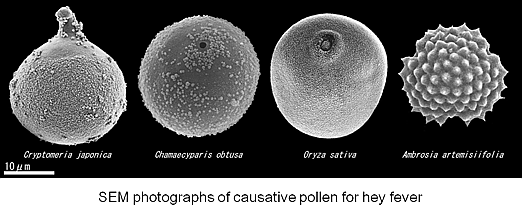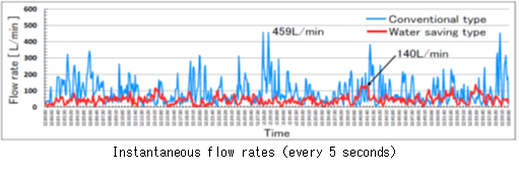-
Faculty of Science, Department of Applied Science
- Associate professor
- Toshiyuki FUJIKI
- Research Field
Paleoenvironmental analysis, Pollen analysis, Pollen morphology
- Keyword(s)
Paleovegetational reconstruction, Human activity, Airborne pollen
- Research theme
-
- Paleovegetational restoration and human activities using pollen analysis
- Measurement of hay fever pollen
Outline of research activities

I reconstruct paleovegetation by pollen analysis contained in sediments such as lakes and marshes, and elucidate how the environment changed in the past. I also research the human impacts on vegetation using charcoal analysis. Currently, I am focusing on the chronological study of human migration to the eastern Polynesia. In addition, we measure airborne pollen, understand the scattering status of hay fever pollen. And we report these data to the Japan Meteorological Association, and forecast scattering for the next year.

- Desired cooperation
-
- Restoration of paleoenvironment around archaeological sites
- Impacts on vegetation from events such as floods, tsunamis, and volcanic ash fall
-
Faculty of Science, Department of Zoology
- Professor
- Kazuyuki MEKADA
- Research Field
Laboratory Animal Science, Experimental Zoology
- Keyword(s)
Animal breeding and genetics
- Research theme
-
- Characterization of wild-derived animals
- Establishment and analysis of novel animal disease models
- Genetic background monitoring of laboratory mice
Outline of research activities


We investigate various biological characteristics such as genetics, morphology, physiological reproduction, and nutrition of wild animals, especially small mammals, through breeding and preservation of their breeding stock (e.g., suncus and voles). To elucidate the diverse biosystems in humans and other animals, we aim to create unique animal resources that enable us to obtain knowledge that is difficult to obtain with common laboratory animals (e.g., mice and rats) and to improve their added value.
- Desired cooperation
-
- Development of techniques for genetic monitoring of laboratory animals,
- Analysis of animal disease models, etc.
-
Faculty of Science, Department of Zoology
- Professor
- Shinya MIZUNO
- Research Field
Regenerative Medicine, Biochemistry, Physiology
- Keyword(s)
Growth Factor, Intracellular Signaling Pathway, Gene Expression, Environmental Adaptation
- Research theme
-
- Molecular basis for HGF-mediated organogenesis
- Molecular basis for HGF-mediated organogenesis
- Basic study on HGF-based self repair therapy of intractable diseases
- Molecular analysis of vertebrate's adaptation to severe winter or drought stresses
Outline of research activities

Hepatocyte growth factor (HGF) was originally identified as an hepatotrophic factor. During the past 30 years, we provided evidence to show that HGF plays an essential role for regeneration of several types of organs, including kidney, lung, hearts and neural tisses, using animal models of intractable disorders. HGF elicits unique biological activities, such as mitogen, motogen and morphgen via activating c-Met/HGF-receptor tyrosine kinase as shown below. Of note, a loss in HGF production is responsible for manifestation of acute and chronic organdiseases. This is the reason why HGF supplemental therapy produces benefit effects against the progression of acute and chronic organ diseases.

- Desired cooperation
-
- Practice of HGF-based self repair therapy in Vet.
- Renal repair, Tendon repair, lung regeneration
- Tissue engineering technique for HGF slow release
-
Faculty of Science, Department of Zoology
- Professor
- Yuji TAKENOSHITA
- Research Field
Primatology, Anthropology, Zoo Sciences, Socio-Ecology, Conservation Ecology, African Studies
- Keyword(s)
Primates, Gorilla, Zoo, Biodiversity Conservation, Africa, Human Evolution
- Research theme
-
- Studies on feeding ecology and life history strategies in wild western lowland gorilla (Gorilla g. gorilla)
- Cooperative breeding among primates
- Evolution of non-reproductive aspect of primate and human sexuality
Outline of research activities




Primates (precisely non-human primates), are the animal group that shares the most similarities with humans. They show high levels of intelligence and social skills. Additionally, many primate species live in tropical and subtropical regions and are considered keystone species that play a fundamental role in maintaining tropical ecosystems. Researching the society and ecology of primates can provide us with valuable insights into the evolution and nature of humans. This knowledge can help us better understand ourselves, as well as contribute to the conservation of biodiversity and the resolution of global environmental issues. My work involves studying the society and ecology of primates and other large and medium-sized mammals, mainly through field observations. I also examine human society from a zoological perspective and its evolution. Currently, my team and I are conducting long-term field research and conservation activities to protect wild gorillas in the tropical forests of Central Africa. We also conduct educational and animal welbeing activities in zoos and perform behavior observation research on Japanese macaques in Japan.
- Desired cooperation
-
- Development of ecological and behavioral data collection equipment and systems in tropical forests using ICT technology
- Practice of local ecosystem conservation activities through collaboration between researchers and citizens ( local community members)
- Zoo-based biodiversity conservation education activities
-
Faculty of Science, Department of Zoology
- Associate professor
- Atsushi NAKAMOTO
- Research Field
Animal Ecology, Behavioral Ecology, Conservation Science
- Keyword(s)
Fieldwork, Wildlife, Ecosystem services, Biocultural diversity
- Research theme
-
- Ecology of flying foxes
- Animal-plant interactions (seed dispersal and pollination)
- Ecology of urban wildlife
- Distribution and ecology of mammals in Okayama Prefecture
Outline of research activities



We focus on the ecology of wild animals, including endangerd species, and their function in the ecosystem using direct observation or research tools such as camera trap. We explore better conservation methods and way for a sustainable coexistence with people.

- Desired cooperation
-
- Ecological survey and conservation activities of endangered animals
- Wildlife management
- Citizen science
- Research on biocultural diversity (collaboration with cultural anthropology and folklore)
-
Faculty of Science, Department of Zoology
- Associate professor
- Ken TAKUMI
- Research Field
Neuroendocrinology, Reproductive physiology
- Keyword(s)
Postnatal development, Hormone, Brain
- Research theme
-
- Development of reproductive functions
- Effects of light-dark cycle on the onset of puberty
- Monitoring of reproductive status by steroid hormones in hair
Outline of research activities

Mammanlian reproductive status changes during postnatal development and aging. It can also be altered by environmental cues, stress or dysfunction of related organs. My research aims to clarify the factors and the mechanism which affect reproductive functions by using histological analysis on hypothalamic-pituitary-gonadal axis and measuring reproductive hormones. I am also working to establish methods to monitor reproductive status of wild animals by measuring steroid hormones in hair.

- Desired cooperation
-
- Histological analysis of peptides and mRNA localization
- Measurement of steroid hormones in hair
-
Faculty of Engineering, Department of Mechanical Systems Engineering
- Professor
- Ichiro SHIMIZU
- Research Field
Solid Mechanics, Elasticity and Plasticity, Strength of Materials
- Keyword(s)
Engineering Solid Materials, Testing Methods of Materials and Products, Metal Forming, Biomedical Devices
- Research theme
-
- Elastic-plastic deformation of engineering materials
- Development of testing methods for materials and products
- Product design considering characteristics of materials
- Functional optimization of solid structures and its application to medical devices
Outline of research activities


Various industrial products are made of solid materials such as metals, polymers, and ceramics. Although all solid materials deform elastically and plastically when forces are applied, their deformation behavior strongly depends on deformation mechanisms. Therefore, it is indispensable to understand their deformation properties to produce useful machines and durable apparatuses. Our laboratory has been working on subjects that aim to apply solid materials for various engineering applications; clarification and evaluation of deformation properties of engineering materials, study on influences of microstructure upon deformation properties of solids, and development of new forming techniques.

- Desired cooperation
-
- Development of testing methods of engineering products
- Development of forming process of engineering materials and its evaluation
- Development of materials having specific deformation characteristics
- Design of solid structures and its application to products
-
Faculty of Engineering, Department of Mechanical Systems Engineering
- Professor
- Keiyu NAKAGAWA
- Research Field
Mechanical Material, Metal Engineering,Fatigue
- Keyword(s)
Soft magnetic amorphous alloy,Age hardening,Fatigue, Ultra-fine grain.
- Research theme
-
- Fabrication of soft magnetic amorphas alloys using liquid quenching method.
- Age hardening of ultra-fine grain aluminum alloys.
- Effect of trace elements on fatigue prpperties for aluminum alloy for air craft.
Outline of research activities

Examination of production conditions for soft magnetic amorphous ribbons by liquid rapidsolidification method using precipitation hardening Cu alloy rolls. In this paper, we investigated that production conditions for amorphous ribbons by liquid rapid solidification method.

- Desired cooperation
-
- High performance of soft magnetic amorphous alloys using liquid quenching method.
-
Faculty of Engineering, Department of Mechanical Systems Engineering
- Professor
- Koji YOSHIDA
- Research Field
Control Engineering, Robotics, Measurement engineering
- Keyword(s)
Multi-body systems, Dynamics, Control, Dynamic mass measurement
- Research theme
-
- Studies on Control Strategy for Multi-body Systems
- Studies on Dynamic Mass Measurement
Outline of research activities

Studies on Control Strategy for Multi-body Systems
We can take each of the machines as a system that is composed of many parts including adjacent parts that are connected by a joint so that they can move relative to each other. We can typically assume that each part is rigid enough that it will never bend or twist while in motion. Such a part is called a rigid body. We can consider industrial robotic arms and even automobiles as systems with rigid bodies. When the rigid bodies in the system move, various forces are applied to the system from the inside. Then, we must ask, what is the relationship between the forces and the motions of the rigid bodies? In the control engineering laboratory, we study such problems for mechanical systems and try to control or measure the mechanical values of the system in order to obtain effective control methods.
Studies on Dynamic Mass Measurement
We also try to obtain effective estimation methods for some mechanical values of the system (including total mass) based on dynamics. Solving the problem of measuring the weights of heavy in-motion vehicles with high precision belongs to the field of dynamic mass measurement.
- Desired cooperation
-
- Control of mechanical systems
- Dynamic muss measurement
- Application of robotic technology
-
Faculty of Engineering, Department of Mechanical Systems Engineering
- Professor
- Ryota HAYASHI
- Research Field
Vertebrate Paleontology, Bone Histology, Evolutionary Biology
- Keyword(s)
Dinosaur, Mammal, Bone Histology, Aquatic Adaptation, Ontogeny
- Research theme
-
- Dinosaur evolution and ecology
- Secondary adaptation of tetrapods to life in water
- Gigantism and dwarfism of vertebrates
Outline of research activities

Bone histology is the study of internal bone tissues, and provides important clues to physiological and ecological aspects of extinct animals such as the growth rate, longevities, potential metabolism and aquatic adaptation.
I am currently conducting researches on bone histology of large tetrapods (e.g., dinosaur, mammal and amphibians) to understand their gigantism, dwarfism and aquatic adaptations.
- Desired cooperation
-
- Researches on living vertebrates (e.g., ecology, anatomy, and pathology)
- Paleoenvironment researches based on geology
- Vertebrate paleontological researches
-
Faculty of Engineering, Department of Applied Chemistry
- Professor
- Yoshiko MORIYAMA
- Research Field
Colloid and Interface Chemistry, Protein Chemistry
- Keyword(s)
Surfactant, Secondary Structure of Protein
- Research theme
-
- Interactions of Surfactants with Proteins and Polypeptides
- Interaction of Surfactants with Proteins Denatured by Urea and Heat treatment
Outline of research activities

The interactions of surfactants with proteins have been widely studied. Recently, an attention has been paid to the effects of surfactants on the secondary structural changes of proteins denatured by another denaturing factor.

- Desired cooperation
-
- Physicochemical Properties of Surfactant Solutions
- Secondary Structural Changes of Proteins
-
Faculty of Engineering, Department of Architecture
- Professor
- Kazuhiko SAKAMOTO
- Research Field
Environmental Engineering, Building Services Engineering
- Keyword(s)
Environmental Planning, Building Services, M&E Engineering Design, Energy Conservation
- Research theme
-
- Study for the New Design method of Water Supply System based on the Dynamic Calculation Method of the Water Supply Demands
- Research on Optimization of Indoor Thermal Environment
- Study fot the most Suitable Operation method about Building Services
Outline of research activities




 One of the important roles of the Building Services Engineering, the follow things must be compatible.
One of the important roles of the Building Services Engineering, the follow things must be compatible.
· Building comfort environments for users.
· Adopting energy conservation techniques for the global warming-control measures.
Air Conditioning System : Explaining the effect of natural ventilation by the Computational Fluid Dynamics program.
Plumbing System : Recently, the follow things are realized.
· Water consumption decreases by using water saving plumbing fixtures.
· Booster pump systems increse.
Therefore, I explain the instantaneous flow rates and study the new design method for water supply system.
- Desired cooperation
-
- Development of the new water supply system
- Energy conservation chek of Building Services
- Development of practical use methods of renewable energy
-
Faculty of Information Science and Engineering, Department of Information Science and Engineering
- Professor
- Hiroshi MATSUURA
- Research Field
Strength of Materials, Universal Design
- Keyword(s)
Artificial joint, Safety design, Non-destructive evaluation
- Research theme
-
- Establishument of evaluation method for universal design -Floor slipperiness measuring dynamic friction coefficient under incremental vertical load -
- Evaluation for strength and safety of artificial joint
Outline of research activities

More than ten thousands people died caused fatal accidents in houses every year in Japan. Among them a number of the aged people died in falling down to flat floor even though without any steps. Floor slipperiness is usually represented as static friction coefficient at the slips in toe-off during last half of gait cycle. However, it is said that slips are also occurred at heel down to floor during first half of gait cycle. In order to evaluate floor slipperiness at heel down, it is necessary to measure the dynamic friction coefficient between footwear and floor under incremental vertical load during the heel down.
 The wear of UHMWPE(ultrahigh molecular weight polyethylene) used in artificial joint is investigated more than 5 million cycles using joint simulator. The simulator is reproduced vertical load, flexion/extension, abduction/adduction and internal/external rotaion during gate cycle.
The wear of UHMWPE(ultrahigh molecular weight polyethylene) used in artificial joint is investigated more than 5 million cycles using joint simulator. The simulator is reproduced vertical load, flexion/extension, abduction/adduction and internal/external rotaion during gate cycle.- Desired cooperation
-
- Floor slipperiness measuring dynamic friction coefficient under incremental vertical load
- Evaluation for strength and safety of artificial joint
-
Faculty of Information Science and Engineering, Department of Information Science and Engineering
- Professor
- Tetsuya AKAGI
- Research Field
Mechatronics, Pneumatic control device, Mechanical control
- Keyword(s)
Soft actuator, Wearable control system, Embedded controller
- Research theme
-
- Development of Low-cost Flexible Pneumatic Actuator and Its Application for Home-based Rehabilitation Devices
- Development of Low-cost Wearable Fluid Control Valve and Its Application
- Development of Various Flexible Robots Using Flexible Pneumatic Actuators
Outline of research activities




By taking advantage of pneumatic actuators that have features of higher force / mass ratio, lightweight and flexibility based on compressibility, we have developed low-cost wearable actuators and low-cost home-based rehabilitation devices that can be disposable after using it. Specifically, we developed a flexible pneumatic cylinder that can be used even if the cylinder bends. A spherical actuator that consists of two flexible pneumatic cylinders have been also developed as an application for portable rehabilitation device. We have also developed a low-cost wearable servo valve using buckled tubes, an artificial muscle with built-in displacement sensor and a pipe inspection robot using extension type flexible pneumatic actuators. In addition, aiming at globalization for students, all graduate students in our laboratory have presentation in international conferences.

- Desired cooperation
-
- Development of wearable pneumatic controlled devices using embedded controllers and its application
- Implementation of low-cost, small-sized and light-weight pneumatic control valves
- Development and application for flexible actuator and flexible sensors
-
Faculty of Information Science and Engineering, Department of Information Science and Engineering
- Associate professor
- Hiroaki KUNO
- Research Field
Bioengineering, Electrical engineering
- Keyword(s)
Biological Information, Measurement, Analysis, Virtual Reality, Robot
- Research theme
-
- Development of remote control robot using body motion
- Development of human action recognition software using security camera images
- Development of sports training software using virtual reality
- Development of biological information measurement system for animals
Outline of research activities



The theme of our laboratory is to measure biological information obtained from humans and animals. Measured biological information is used in the development of various sensors, equipment, and software.

- Desired cooperation
-
- Downsizing of system
- Development of application software
- Development of telecommunications technology
-
Faculty of Information Science and Engineering, Department of Information Science and Engineering
- Associate professor
- Wataru KOBAYASHI
- Research Field
Control, Rehabilitation, System Engineering, Fluid mechanics
- Keyword(s)
Fluid Power System, Rehabilitation, Life Support System, Green Drive Source
- Research theme
-
- Control of tap-water drive artificial muscles
- Assist orthosis for under-water gait training
- Pure tap-water drive system for emergency drive source
- Support systems for musical instruments
Outline of research activities


Water hydraulic systems which use tap-water as working fluid are called aqua drive systems and they can realize novel green drive sources with 100% oil-free characteristics. In our laboratory, we study to realize a clean and safe system for rehabilitation, power assist, and life support. In addition, we have developed pure aqua drive systems, which can be driven without any power source, by controlling fluidic flow and have applied such systems to emergency drive sources and disaster prevention systems. We have also developed support systems to play musical instruments by only one hand.

- Desired cooperation
-
- Application of aqua drive systems for rehabilitation and life support systems
- Development of emergency drive source and disaster prevention systems using pure aqua drive systems
- Development of support systems for musical instruments
-
Faculty of Life Science, Department of Bioscience
- Professor
- Da-Hong WANG
- Research Field
Environmental Public Health, Environmental Biochemistry
- Keyword(s)
Environment, Assessment of Exposure Effects, Functional Foods, Disease Prevention, Biomarkers
- Research theme
-
- Assessment of exposure effects of environmental substances
- Development of Functional foods
- Examining the psychological and physiological effects of the forest environment on humans
Outline of research activities

We are developing the simple and effective methods for screening oxidative stress-induced environmental substances, and the functional foods to control the toxicity of environmental substances. Furthermore, in order to understand the psychological and physiological effects of the forest environment on humans, we are conducting comparative studies using biological oxidative and antioxidant biomarkers as indicators.

- Desired cooperation
-
- Health assessment of functional foods
-
Faculty of Life Science, Department of Bioscience
- Professor
- Jun NAOHARA
- Research Field
Environmental analytical chemistry, Water processing technology, Ultimate analysis
- Keyword(s)
Advanced Oxidation Process, Toxic element, Ultraviolet rays processing, ICP-MS
- Research theme
-
- Decomposition of environmental polluted material by AOP method.
- Ultimate analysis of the biospecimen and environmental sample by ICP-MS.
- Water processing technology development with the excimer lamp.
Outline of research activities

· We establish a water processing technology with the excimer lamp which does not include mercury. We perform the characteristic evaluation of the new source of light and consider whether we are established as a substitute new technology.
· The element concentration of human hair living in the same area and element concentration in water to drink are measured by ICP-MS. We examine relationship between toxic element concentration in hair and water element concentration.
· The production distinction of the farm products by stable isotope ratio analysis and the trace element analysis and marine products is studied.
- Desired cooperation
-
- Technology development of the treatment of environmental pollution material.
- Ultimate analysis of the environmental sample and biospecimen.
-
Faculty of Life Science, Department of Bioscience
- Professor
- Masayuki HARAMURA
- Research Field
Mdicinal & Bioorganic Chemistry, Chemical Biology
- Keyword(s)
Peptide Chemistry, Chemical Proteomics
- Research theme
-
- Design and synthesis of bioactive organic molecules.
- Development of a method for analyzing intermolecular interaction between proteins and bioactive small molecules.
Outline of research activities


・Peptide-based drug design and synthesis:
Design and synthesis of bioactive small molecules from peptide hormons and proteins based on structure activity relationships.
・Chemical Biology Research:
Development of a method for discovery of novel drug target protein using small bioactive compounds as the probes.
- Desired cooperation
-
- Peptide based drug design and symthesis
- Discovery of novel drug target protein of small bioactive compounds
-
Faculty of Life Science, Department of Bioscience
- Professor
- Motonao NAKAMURA
- Research Field
Cellular signaling, G protein coupled receptor (GPCR)
- Keyword(s)
receptor, GPCR, signal transduction, molecular biology
- Research theme
-
- Functional studies on the desease-related GPCRs
- Development of novel ligands for target GPCRs
- Fundamental study on the GPCR biology
Outline of research activities

G protein-coupled receptors (GPCRs) utilize complex cellular systems to respond to diverse ligand concentration. Our recent work elucidated that this system functions through the phosphorylation status. Thus, we have been studing on the potential roles of this modification for the GPCR signaling. In addition, we are developping the novel ligands for desease-reated GPCRs to regulate. We hope that our studies provide an expanding conceptual view of the drug development for the regulation of GPCRs.

- Desired cooperation
-
- Screening and development of bioactive ligands for GPCRs





